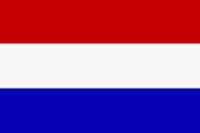Kingdom of the Netherlands
 The Netherlands, country of porn, croquettes and drugs. Country of traffic jams, consensus, speed skating and audacious art. There is a saying that God created the world but the Dutch made the Netherlands. The very word “Netherlands” means low lands. The country is located on the North Sea, and large areas lie below sea level; its lowest point is more than 22 feet below sea level and its highest only about 1,050 feet above. The nation’s geography has shaped its history and culture. Through the centuries, the Dutch have prevailed against the sea by hard work and constant vigilance, yet water and ocean winds have also been a boon, resources that played a key part in the success of the Netherlands.
The Netherlands, country of porn, croquettes and drugs. Country of traffic jams, consensus, speed skating and audacious art. There is a saying that God created the world but the Dutch made the Netherlands. The very word “Netherlands” means low lands. The country is located on the North Sea, and large areas lie below sea level; its lowest point is more than 22 feet below sea level and its highest only about 1,050 feet above. The nation’s geography has shaped its history and culture. Through the centuries, the Dutch have prevailed against the sea by hard work and constant vigilance, yet water and ocean winds have also been a boon, resources that played a key part in the success of the Netherlands.
The name 'Holland' is often used to refer to the whole of the Netherlands, although this is not formally correct [similar to the tendency to refer to the United Kingdom as "England"]. Holland is a name in common usage given to two provinces in the western part of the Netherlands. The people of Holland are referred to as "Hollanders" in both Dutch and English. When referring to the Netherlands as a whole, the adjective is "Dutch".
The 'Orange' of the House of Orange originates from the small town in the South of France. William The Silent, son of the Prince of Nassau (in Germany), inherited the title to the House of Orange through family connections. The Royal Household is still today the House of Orange-Nassau. Orange is the Dutch national color. But the Dutch flag is red, white and blue.
The Dutch bulb trade, established in the 17th century, was probably the world's first forward commodities market. In 1636, a single tulip bulb was sold for 5,400 guilders, more than a substantial Amsterdam house cost at the time. Tulip bulbs were originally brought to the Netherlands from Turkey.
The export of fresh flowers is still a major Dutch industry. As of 1 January 2002, the Dutch cooperative combining two flower auction houses, FloraHolland, has become one of the world's largest auction organisations. Its annual sales in 2006 were EUR 3,9 billion. 85% of these sales were exported, mainly to other EU member states.
The coastal position of the Netherlands has always been of great importance to the Dutch economy. This importance is increased by the fact that three major West European rivers - the Rhine, the Meuse and the Scheldt - flow into the sea via the Netherlands. The Dutch economy is internationally oriented. The Netherlands is one of the most dynamic trade and industry centres in the European Union. Due to its geographical location, the Netherlands plays an important role as a main port and distribution location. The seaport of Rotterdam processes around 327 million tonnes of cargo each year and has been the largest seaport in the world for over 35 years. Amsterdam Airport Schiphol, the international airport, is the fourth largest cargo airport in Europe.
The Kingdom of the Netherlands consists of the Netherlands in Western Europe and the islands in the Caribbean. The European part of the Kingdom has a surface area of 41,528 km2. To the north and west the country is bordered by the North Sea, to the east by Germany and to the south by Belgium. With 16 million inhabitants and an average of 459 people per square kilometer the Netherlands is one of the most densely populated countries in the world. The vast majority of the population lives in what is called the ´Randstad, the urban area surrounding and including the four main cities in the west of the country: Amsterdam, The Hague, Rotterdam and Utrecht.
The Netherlands is a small and densely populated country. Its economy depends on industry (particularly chemicals and metal processing), intensive agriculture and horticulture, and infrastructure, which takes advantage of the country's geographical position at the heart of Europe's transportation network. These factors have led to major pressure on the environment. The government works closely with industry and nongovernmental organizations to reach environmental targets. The Dutch welcomed the EU's 2008 directive to cut greenhouse gas (GHG) emissions 20% from 1990 levels and increase power derived from renewable sources to 20% by 2020. The Netherlands has a binding national target to reduce emissions in sectors not covered by the EU emissions trading system by 16% in 2020. It also has a binding national target of 14% in 2020 for renewable energy. Many independent energy experts, however, consider the government’s aggressive climate change targets to be overly optimistic.
|
NEWSLETTER
|
| Join the GlobalSecurity.org mailing list |
|
|
|

